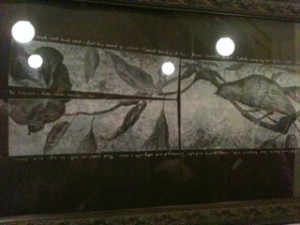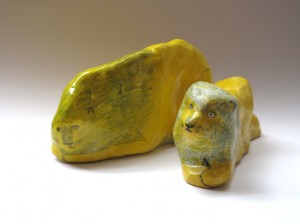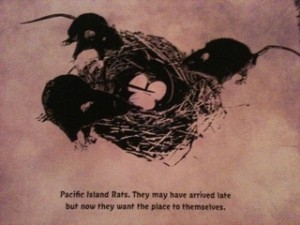
One of the questions that children always ask all authors is ‘where do you get your ideas from?’ I’m always tempted to say, ‘In aisle six at Tescos, just above the fair trade coffee.’ or something similarly daft. What I actually do say is something like ‘From the natural world’, and then I cringe because it sounds as if I’m describing a kind of Lourdesian visionary experience. What I suppose I mean is that my motivation comes from the natural world, and obviously, if you’re writing a book about snakes, as I just have been, then your ideas come from, well… snakes. (No no I don’t mean snakes speak to me…even if they did I’d imagine snake speak is pretty limited in its scope ).
So the ‘Natural world’ answer isn’t really a truthful response to the question. What I’m answering is ‘why’ , when they are asking ‘where?’ and also to a certain extent ‘how?’
And that’s a lot more tricky. When I’m squeezing a book out slowly and painfully, like very old dried up toothpaste, I could probably name the little moments of blessed lubrication that allow the story to progress. The snake book was like that. I’d kind of lost count of the various drafts I’d done of the damn thing, all differing slightly from one another like a suite of closely related butterfly species. I returned the the text miserably, feeling a bit like Hugh Jackman looks in the opening shots of Les Mis. I knew what I wanted the book to do, which was to start from the list of things that people find scary about snakes, and to pop the fears and prejudices like so many balloons. I had a bagful of snake facts ready to use and some little tricks with rhyme and rhythm that worked for a page or two but kept running out of energy like cheap batteries. And then I had an idea. Not a big idea like gravity or quantum mechanics. This idea was a voice (nooo I told you, snakes do not speak to me) the voice of the youngest child in a family. The voice of the child who doesn’t fit in, who says the things no one approves of and gets into trouble. Well the tiniest bit of home psychology could tell you where that voice comes from – I’ve never fitted in anywhere. This voice was saying that it doesn’t like snakes, and in a family of snake enthusiasts that isn’t a popular opinion.
A tiny idea, an idea-lette really, but it solved my book, and after that it took just two days of fiddling about to make it work.
What’s much more difficult is to see what happens when a text just rushes out onto the page, so it feels like someone else wrote it. That doesn’t happen to me very often but it happened just before Christmas in the picture book text I was writing for Mark Hearld. I had been cooking the ingredients – pigeon navigation and homing, racing pigeons, belonging and displacement – in my head for a year or more. And I’d heard the little voice of the narrator, and seen them wandering somewhere, lost alone and in a new an entirely unfamiliar place. What I don’t know is exactly when and how that lost place became the South Wales valleys in the 1920s and the child became the son of an Italian immigrant family.
What I do know now, is that when that happened, it was an extremely good and lucky thing, because the story really works and it strikes a chord with all the poeple I’ve read it to. Last week, at the fabulous Spatilaising Illustration conference the response was amazing. Two people told me afterwards how it connected with their own Italian Welsh family histories and I realised I had just lifted the edge of something and there were many many more stories to be found underneath.
I suppose I don’t really know where those moments, those ideas, insights, voices come from, but I am beginning to learn how to make my brain more likely to come up with them when they are needed. I’m beginning to trust that if I just put the right stuff in, and then give myself some space and some licence, then the right stuff will come out with a greater or lesser amount of squeezing. Mostly reading novels doesn’t put the right stuff in – poetry does (reading sean Borodales Bee Journal now and Philip Gross Deep Field…both AMAZING) and visual art does – and being with other people who write, paint, draw, make, do REALLY does. After last weeks conference, Spatialising Illustration in Swansea I felt nourished, as if my internal larder had just had a huge delivery from Fortnum and Mason.
Hearing Laura Carlin speak about her work, and seeing shots of her sketchbooks and ceramics was like a shaft of the very best  and purest spring sunshine. All the best art comes from a true place I think, and Laura’s work comes from the truest soul. Her work is consistent with her nature and her life and her history, the clarity and simplicity of that straight line made me want to write like that. The images she creates are simply ravishing to the senses and the heart. They steal away your heart. You have no choice when looking at Laura’s work but to engage with it completely, and for a moment be taken right out of yourself and into to world.
and purest spring sunshine. All the best art comes from a true place I think, and Laura’s work comes from the truest soul. Her work is consistent with her nature and her life and her history, the clarity and simplicity of that straight line made me want to write like that. The images she creates are simply ravishing to the senses and the heart. They steal away your heart. You have no choice when looking at Laura’s work but to engage with it completely, and for a moment be taken right out of yourself and into to world.
There was lots of talk about the spaces between things “the potency of negative space.”.
Laura spoke about what you don’t show in illustration, what you leave out. There was some very precise technical talk about exactly what illustration does and how it does it. I was made to think about what margins and gutters do to define images and about how eyes read pictures. I heard wonderful definitions of illustration – ‘the space between art an entertainment’ and saw new things that it could do: Mitch Miller from Glasgow school of art using illustration to tell stories about whole community and to map its history and culture onto map-drawings, drawing-maps of the streets that have shaped it; Chris Aldhous’ drive to make illustration into an organ of ‘narrative persuasion’ in his creation of the exhibition ‘Ghosts Of Gone Birds’ which brings the spectre of extinction and how to avoid it to a new audience.
 All of this was such a wonderful re stocking of my resources precisely because illustration is not what I do. I would love to be a visual artist but I’m not, but what illustration does is what I try to do with my writing, which is to pack information – fact, emotion, insight interpretation – into a single image or moment. Seeing how illustrators do this (Mitch’s street maps, Laura’s sketchbooks, Geoff Grandfield’s stunning book covers) shows me what is possible, spurs me on to try harder, do better.
All of this was such a wonderful re stocking of my resources precisely because illustration is not what I do. I would love to be a visual artist but I’m not, but what illustration does is what I try to do with my writing, which is to pack information – fact, emotion, insight interpretation – into a single image or moment. Seeing how illustrators do this (Mitch’s street maps, Laura’s sketchbooks, Geoff Grandfield’s stunning book covers) shows me what is possible, spurs me on to try harder, do better.
And it simply makes me happy, fills me up with delight. Experiencing other peoples describing, explaining and interpreting gives me a window, for a moment, into who and what they are, a moment of connection, a spark of shared reality. It reminds me that describing, explaining and interpreting is what we humans are for, that life is for learning new things all the time and making sense of them…and that sense might be art or it might be science.
In the last book of his ‘Mortal Engines’ series, Philip Reeve describes his robot character, rusted, broken but still ‘alive’ waking after a long period of being ‘off’; waking to tell the story of all he’s seen in his long existence, and saying that that is his purpose, to be an engine for telling stories. In that moment the robot machine is clearly profoundly human, engaged in the life long weaving of ever changing, ever expanding narratives. Being reminded that that is the process in which my life is engaged makes me want to restock, renew and set up the space for ideas to come, even if where they come from and how they get here is still a bit of a mystery.
And as a little post script
Some favourite nuggets from the last ten days:
‘To make a drama a man needs on passion and four walls.‘ Alexander Dumas
‘Art is no good unless it is left alone o be itself’ Wila Catha
‘Art versus extinction. Raising an army for conservation.’ Chrsi Aldhous, Ghosts of Gone Birds
‘The act of drawing drives the cognitive process’ Alan Walker
‘The place feeling in my mind is the feeling of not completely visualising a room in a novel’ Bella Kerr
‘I think, each bees six heels may be callipers for cell’s wall angles’ Sean Borodale , Bee Journal
‘We can’t grasp the surface, so we call it deep’ Philp Gross, Deep Field
